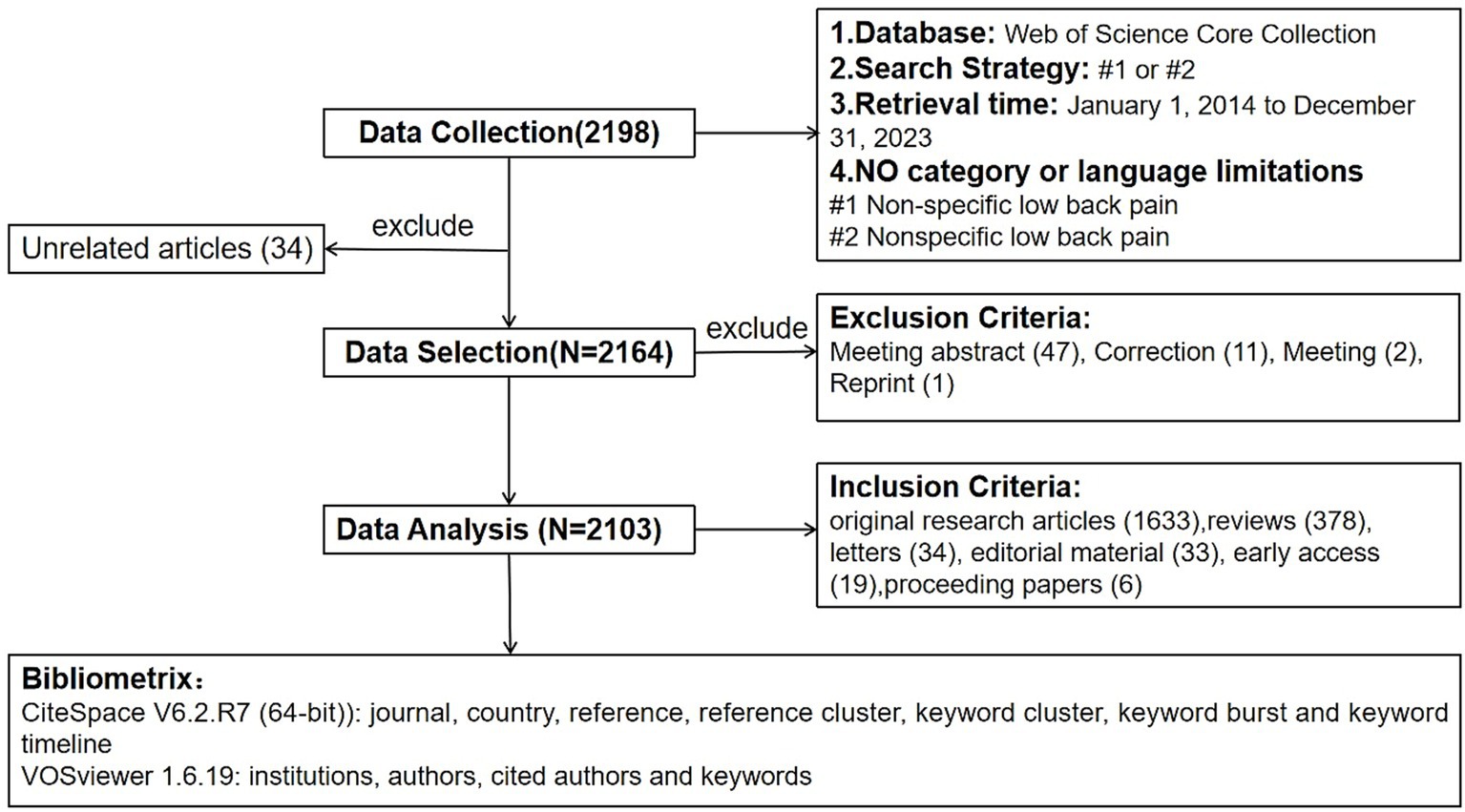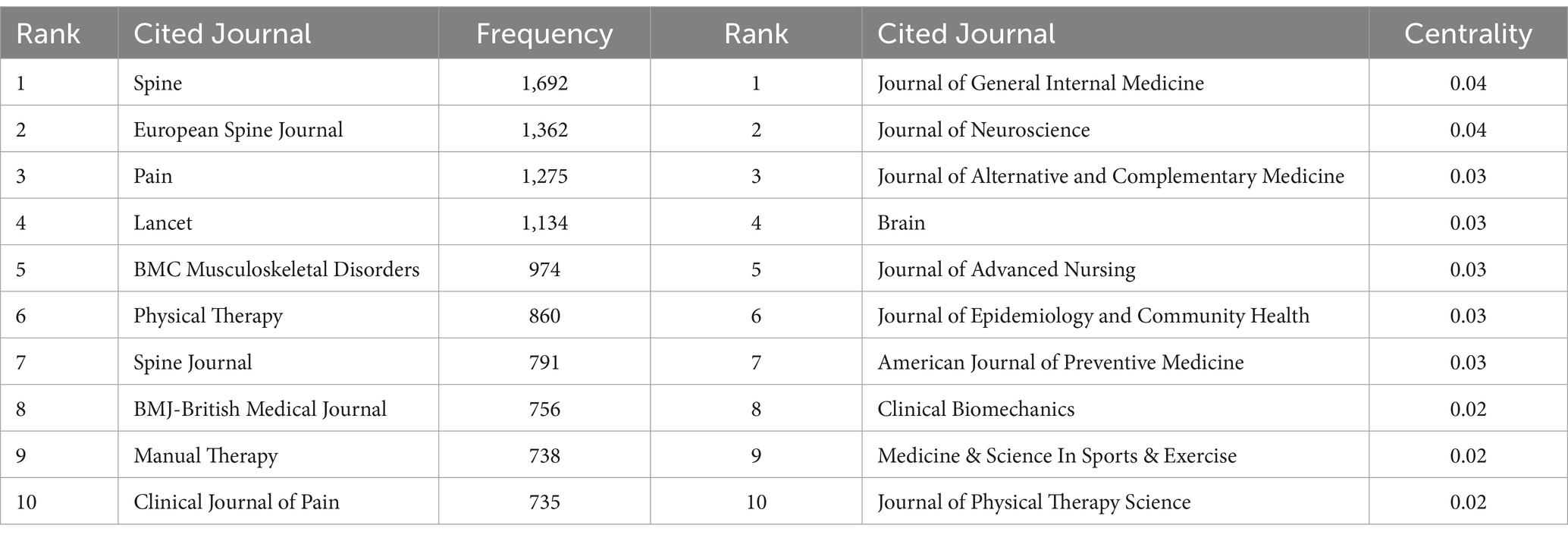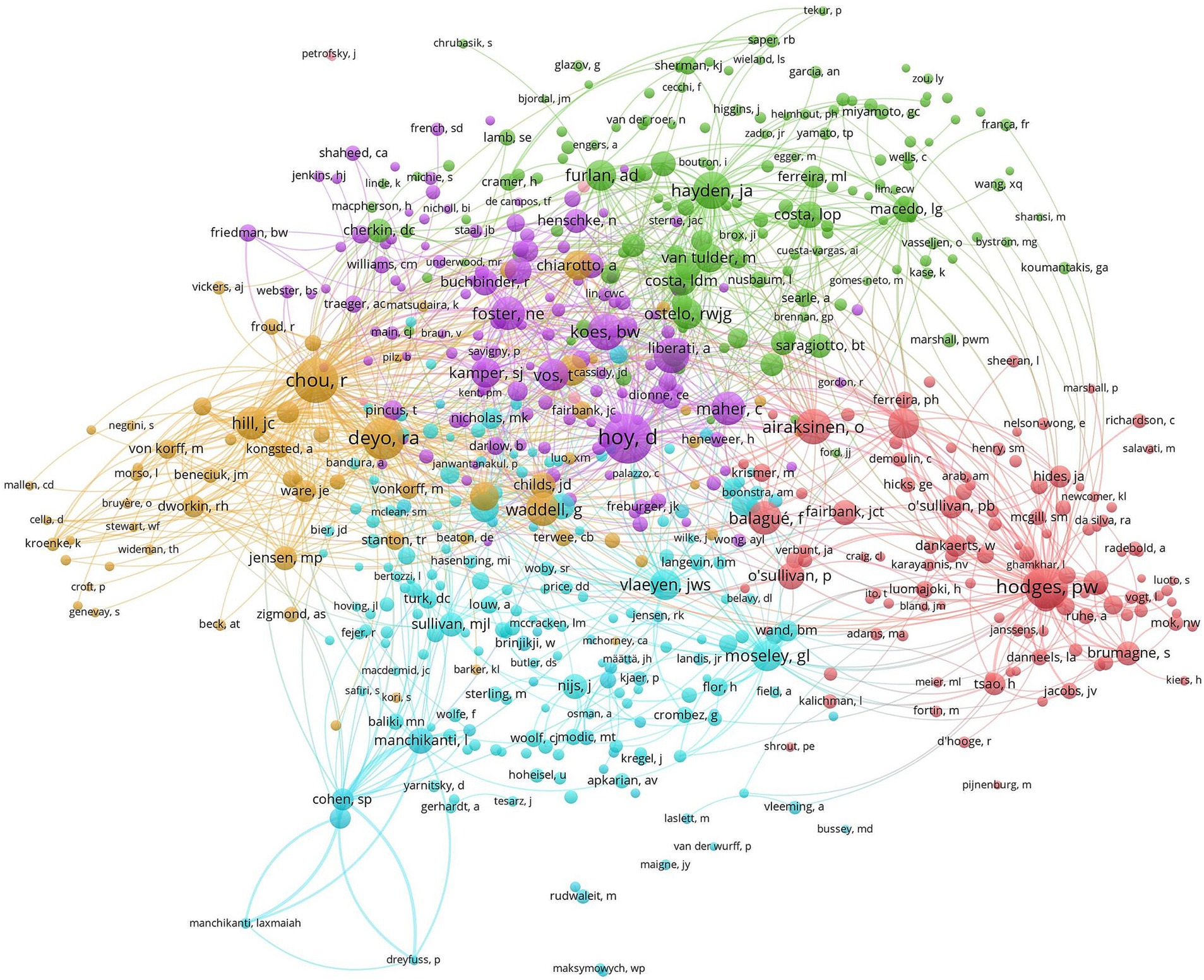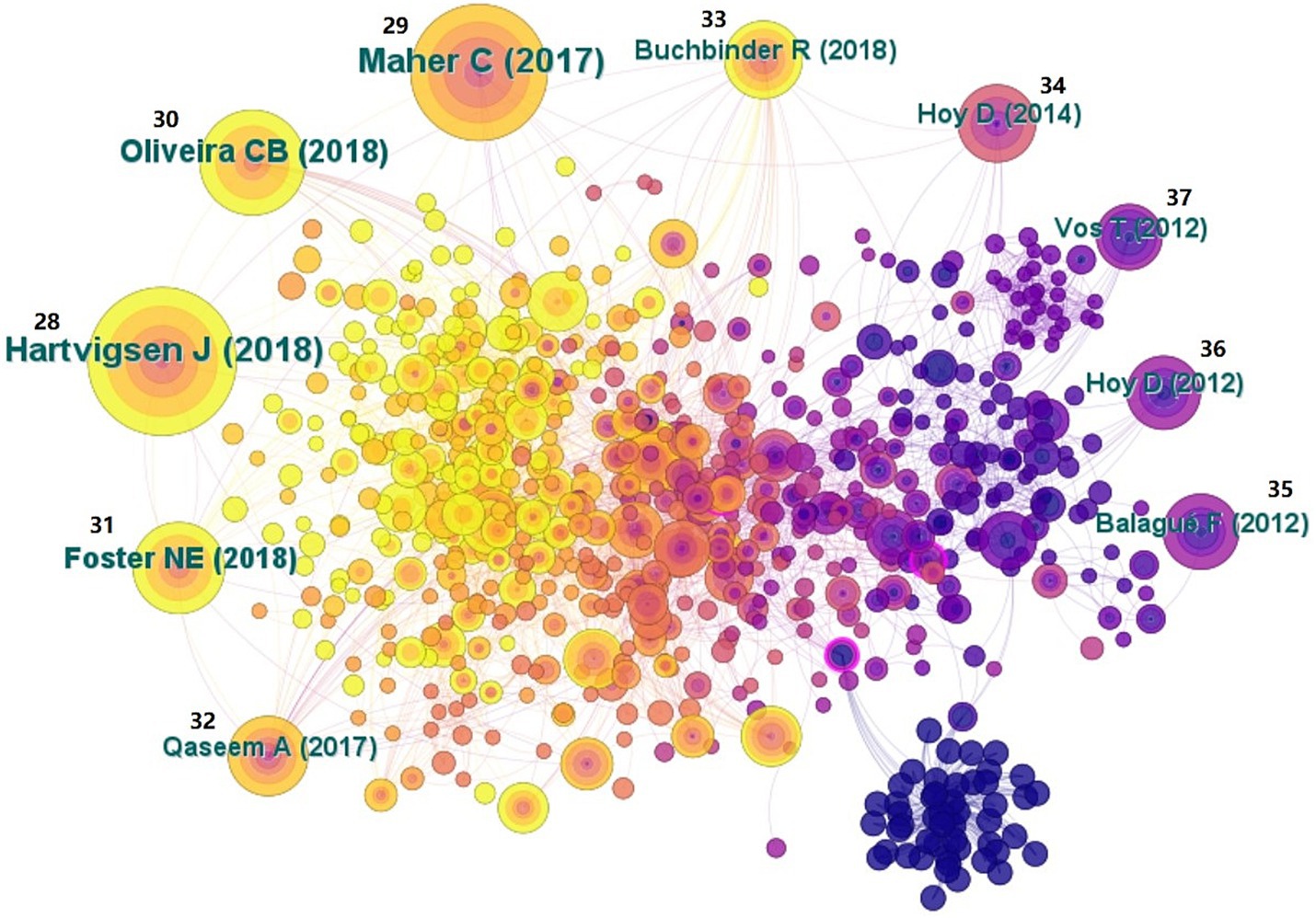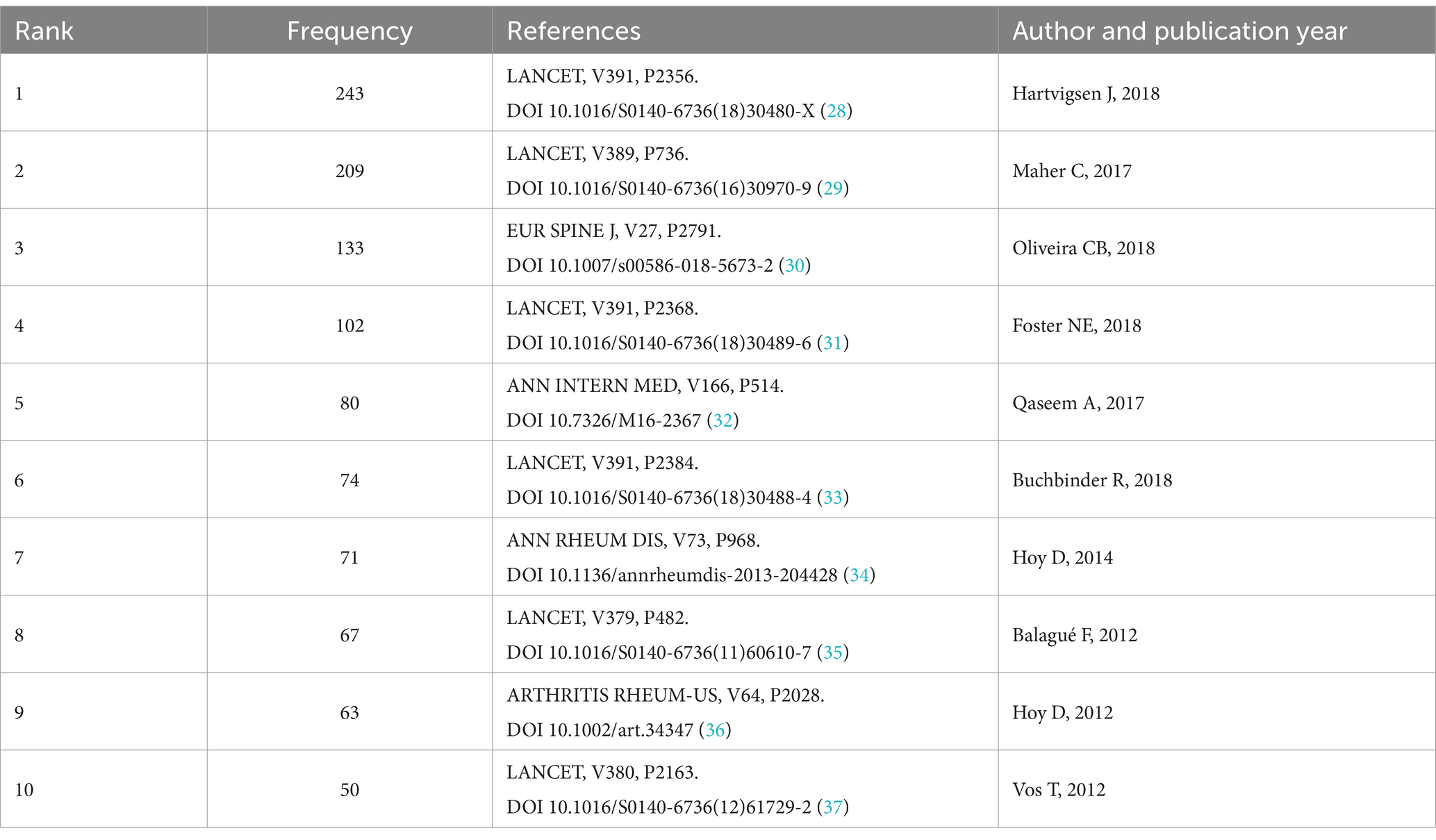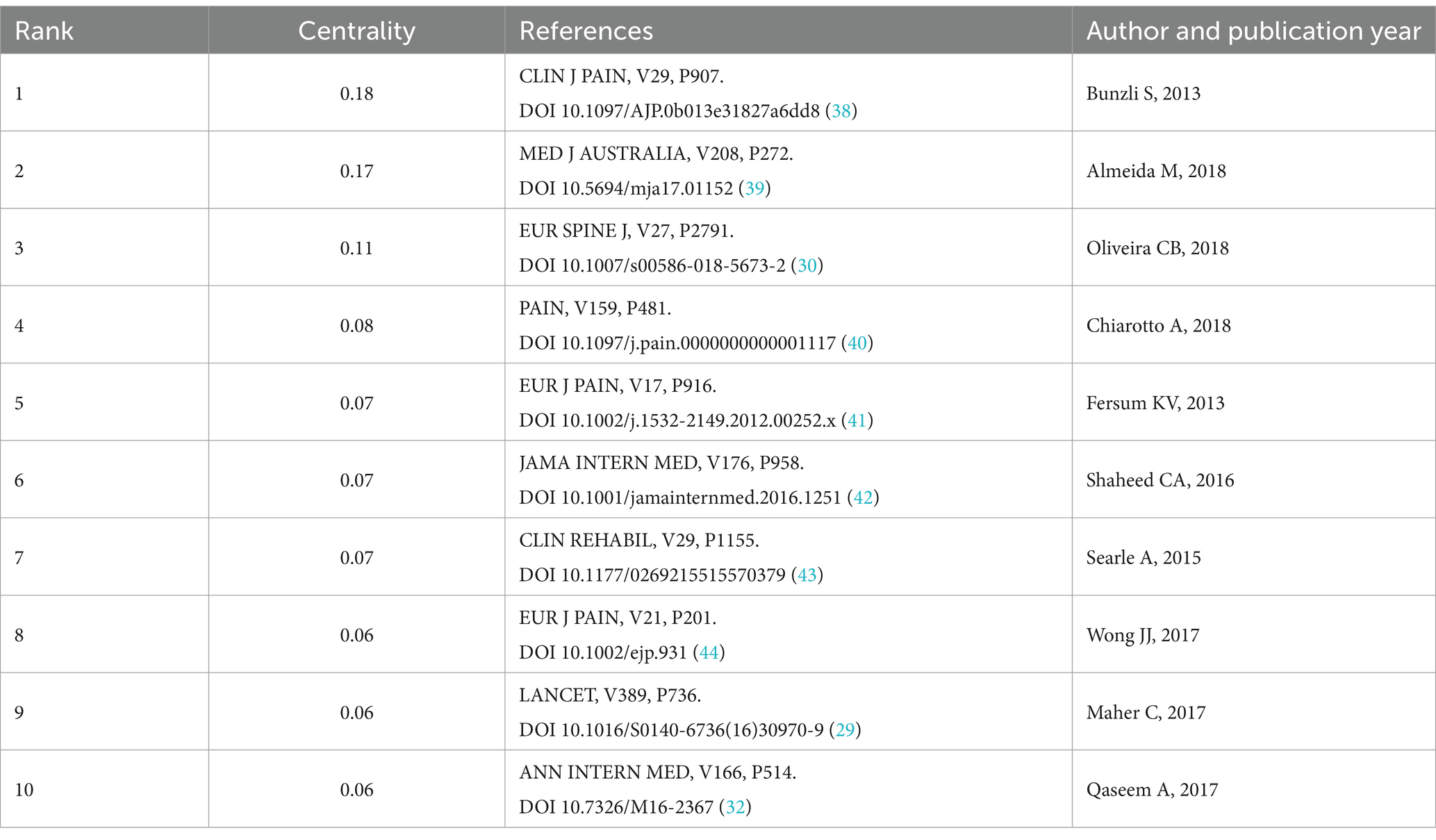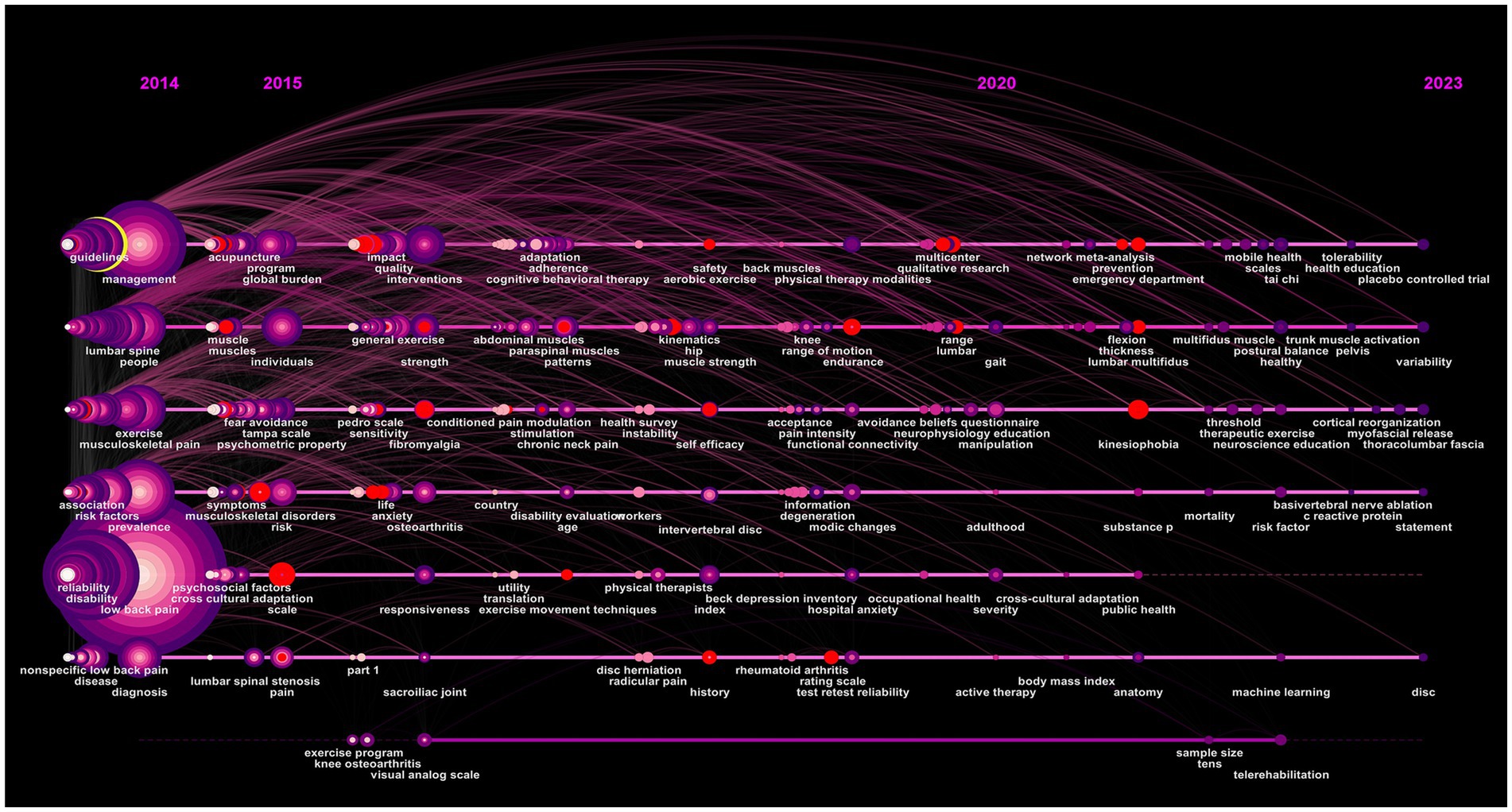- 1Acupuncture and Moxibustion Department, Affiliated Hospital of Jiangxi University of Chinese Medicine, Nanchang, Jiangxi, China
- 2Acupuncture and Moxibustion Massage College, Jiangxi University of Chinese Medicine, Nanchang, Jiangxi, China
Background: Extensive research has been conducted worldwide on non-specific low back pain (NSLBP), some researchers published a bibliometric analysis of NSLBP in 2020, but there have been no supplements or updates since then. Therefore, this study aimed to analyze the research hotspots and frontiers in NSLBP over the last decade.
Methods: Primary sources on NSLBP were obtained from the Web of Science Core Collection database from 2014 to 2023. CiteSpace V6.2. R7 (64-bit) and VOSviewer 1.6.19 software were used to analyze the number and centrality of journals, countries, institutions, authors, references, and keywords, and the functions of co-occurrence and clustering were applied to draw a visual knowledge map.
Results: In the past decade, the annual publication volume of studies on NSLBP has shown an overall upward trend year by year, with obvious temporal stages and great development potential. In total, 2,103 articles contained six types of literature, with the highest proportion being original research articles (1,633 articles, 77.65%), published in 200 journals. BMC Musculoskeletal Discourses (90 articles, 4.28%) had the highest number of publications, and the British Medical Journal had the highest impact factor (105.7). Furthermore, the United States of America (329 articles, 15.64%) had the highest publication volume, the University of Sydney (139 articles, 6.61%) was the research institution with the highest production, Maher, Chris G (36 articles, 1.71%) was the author with the most published articles, and Hoy, D (571 articles, 27.15%) was the most frequently cited author. The most cited of articles is “Non-specific low back pain” published in the LANCET, with 1,256 citations.
Conclusion: This article summarizes the current research status of NSLBP and predicts future research hotspots and frontiers. In recent years, adolescents have become a high-risk group for NSLBP. Pain neuroscience education, motor control, spinal manipulative therapy, and acupuncture are effective means to treat NSLBP. Biomechanics and trunk muscles as entry points are effective ideas for the treatment of NSLBP pain. Furthermore, anxiety, neck pain, non-specific musculoskeletal pain, fibromyalgia, and musculoskeletal disorders are diseases that are closely related to NSLBP. In the future, attention should be paid to the design of research plans, increasing the research intensity of randomized controlled trials, strengthening follow-up, and the timely updating of guidelines, which will result in higher quality and high-level scientific evidence for research on NSLBP.
1 Introduction
According to authoritative statistics, low back pain (LBP) affected approximately 568 million people worldwide in 2019 (1). A systematic review of 56 countries shows that the lifetime prevalence of LBP is as high as 40%; as a result, LBP is one of the most common musculoskeletal disorders (2). In the United States of America (USA), LBP has the highest overall healthcare expenditure, estimated at $134.5 billion in 2016 (£95 billion; €110.5 billion), with a 95% confidence interval (CI) of $122.4 billion to $146.9 billion (3). LBP can be divided into specific and non-specific types. Non-specific low back pain (NSLBP), where the specific pathological and anatomical reasons cannot be determined, accounts for 80–90% of cases (4, 5). In addition, more than 60% of patients may experience pain and disease recurrence after 1 year of onset, progressing to chronic NSLBP. Thus, NSLBP is a major global public health problem that imposes a huge burden on individuals, healthcare, and society, and has been a major cause of disability worldwide for the past 30 years (6–8).
The pathogenesis of NSLBP has not been elucidated. Currently, there are many methods for treating NSLBP in clinical practice, which can be roughly divided into drug treatments and non-drug treatments. Drug therapy is a first-line treatment method for NSLBP and is widely used in clinical practice. Drug therapy usually requires clinical doctors to develop specific medication plans and make necessary adjustments, and commonly includes nonsteroidal anti-inflammatory drugs (NSAIDs), muscle relaxants, and analytical medicine (9–12). However, drug therapy can have certain side effects and uncertain therapeutic effects. For example, NSAIDs can have adverse effects on the cardiovascular and gastrointestinal systems, while analgesic drugs have uncertain long-term efficacy and can become addictive (13). Given the high cost, side effects, and limited efficacy of drug therapy for NSLBP, various NSLBP treatment guidelines and consensus published in recent years recommend the use of non-drug means, including various sports treatments (14–16), physical factor treatments (17), and acupuncture replacement therapy (18, 19).
Bibliometrics is an interdisciplinary science that quantitatively analyzes all knowledge carriers. It uses mathematical and statistical methods to manage literature, analyze the academic level, research direction, and academic trends of different disciplines (20–22).
At present, no bibliometric analysis of NSLBP exists; therefore, this study aimed to explore the hotspots and frontiers of research on NSLBP in the past decade to provide some assistance for future research directions.
2 Materials and methods
2.1 Source of literature
We performed a bibliometric analysis of research articles on NSLBP published from January 1, 2014, to December 31, 2023, obtained from the Web of Science Core Collection (WOSCC) database, with a search date of March 3, 2024. Our search terms included ST = (Non-specific low back pain) or (Nonspecific low back pain). Searches were not limited to the category or language of literature. Searches were conducted independently by Shiqi Xu and Desheng Wu; when discrepancies arose, they were resolved by Yuqing Wang. A total of 2,198 articles were retrieved, and 34 articles unrelated to the topic were excluded, leaving 2,164 articles. Following a CiteSpace software check, no duplicate articles were detected. To ensure the effectiveness of the research conclusions, short passages or incomplete articles were not included in the analysis. Therefore, we excluded 47 meeting abstracts, 11 corrections, two meetings, and one reprint, resulting in 2,103 articles for the final bibliometric analysis (Figure 1). Data deletion was done as a combination of manual validation and the CiteSpace software. The Web of Science search was sourced from the Jiangxi University of Chinese Medicine Library’s database.
2.2 Analysis tools
CiteSpace is a tool used to analyze the scientific literature developed by Dr. ChaoMei Chen in conjunction with the WISE Laboratory. The software is based on co-citation analysis and pathfinding network algorithms to visualize data samples and present the evolution of a specific knowledge domain (23, 24). VOSviewer is a JAVA-based software tool developed by Van Eck and Waltman from the Leiden University Science and Technology Research Center in the Netherlands in 2009. It showcases the knowledge structure and relationships in the research field through co-citation and co-citation principles. Both software tools can visualize the relationships between the literature in the form of a scientific knowledge map. This not only helps us clarify the past research trajectory, research status, and hot topics of a certain field but also reveals the future development direction of the field (25–27). This study used CiteSpace V6.2.R7 (64-bit), VOSviewer 1.6.19, and Excel to determine trends in authors, journals, institutions, countries, and keywords.
3 Results and discussion
3.1 Analysis of the annual volume of publications
The annual number of publications can reflect the time-series change of a scientific issue and is an important indicator in bibliometrics. Excel software was used to produce an annual chart of the distribution of article publications (Figure 2). The number of articles published on NSLBP in the past 10 years has fluctuated slightly; however, overall a steady upward trend was observed, which could be divided into three growth phases. The first phase (2014–2016) was the exploratory period, with the literature increasing from 131 to 180; the second phase (2017–2020) was the accelerated period, with the literature increasing from 169 to 266; and the third phase (2021–2023) was the stabilization period. The factors that lead to these different phases may be the reason for the fluctuation of publication rates in different phases. It is noteworthy that in the second phase, it enters a new height, with an accelerated increase in literature publication, reaching an all-time high in 2020, with 266 annual publications (12.65%). We have demonstrated high reliability of the trend line by calculating the slope (y = 13.848x + 134.13; R2 = 0.7842). The research results indicate that NSLBP has received sustained attention from researchers, and the research momentum is strong, with enormous potential.
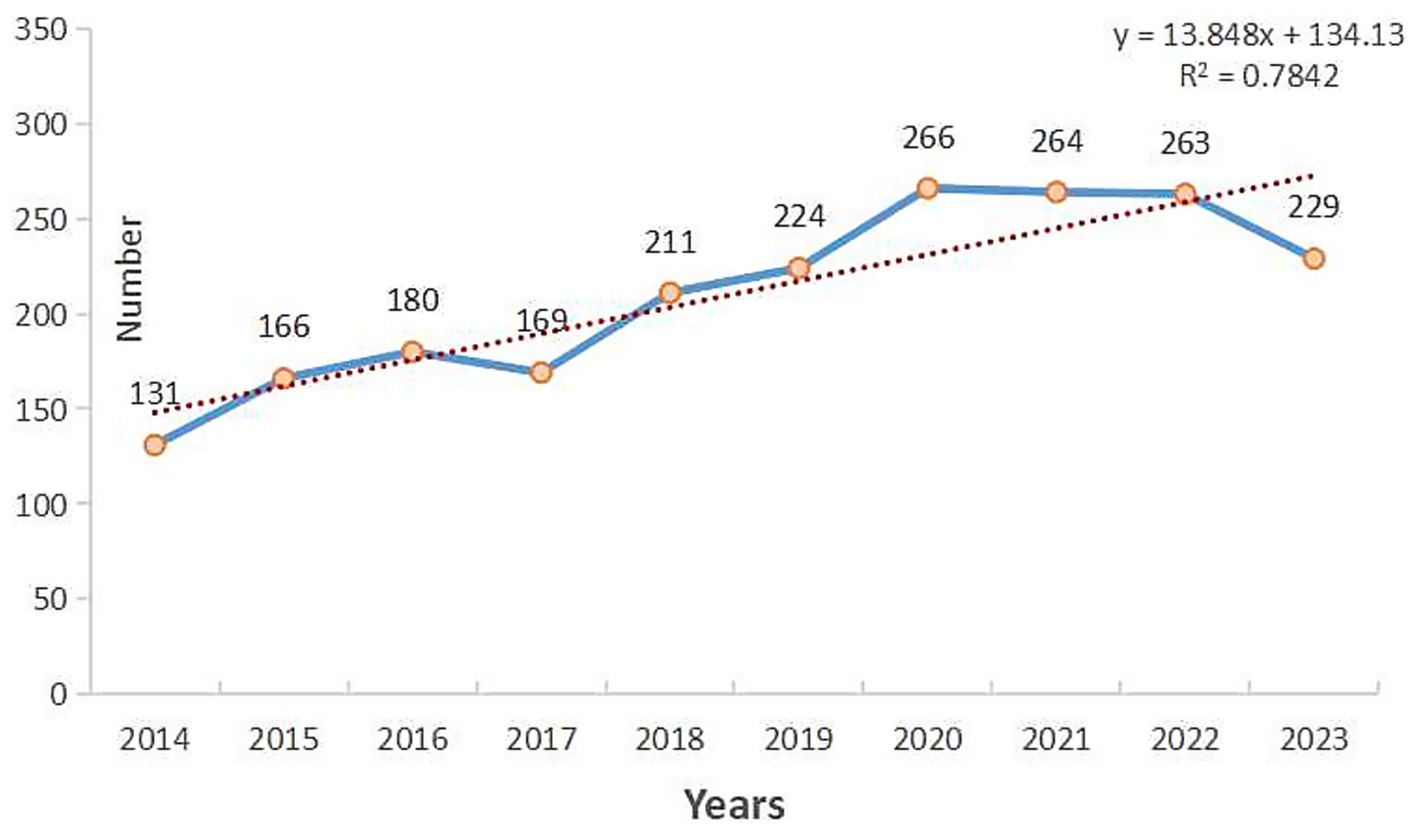
Figure 2. The annual number of publications related to non-specific low back pain (NSLBP) from 2014 to 2023.
3.2 Analysis of journals and cited journals
The 2,103 articles were categorized into six types of publication. The most common type was original research articles (1,633 articles, 77.65%), followed by reviews (378 articles, 17.97%), letters (34 articles, 1.62%), editorial material (33 articles, 1.57%), early access (19 articles, 0.90%), and proceeding papers (6 articles, 0.29%) (Table 1). The 2,103 articles were published in 200 journals, with the highest number of articles published in BMC Musculoskeletal Disorders (90 articles), followed by the European Spine Journal (68 articles), the Journal of Back and Musculoskeletal Rehabilitation (67 articles), PLoS One (61 articles), and Spine (56 articles); the 6th to 10th positions are shown in Table 2. Referring to the Journal Citation Report 2023 of the American Institute for Scientific Information, we found that among these journals, the journal with the highest impact factor (IF) was the British Medical Journal (IF = 105.7). The most cited of the 2,103 articles is “Non-specific low back pain” published in the LANCET, with 1,256 citations.
Combining co-citation and centrality, CiteSpace was used to generate a network map of the cited journals (Figure 3 and Table 3). Centrality is a concept that refers to the degree to which nodes (such as authors) are close to the center in the entire literature network, usually the higher the centrality suggests that the nodes are more important. The nodes in the figure represent the cited journals, and the connections between nodes represent co-cited relationships. The larger the node range, the higher the number of co-citations. The purple ring represents centrality, with nodes with high centrality being important key points. The top journals in terms of frequency and centrality were Spine and the Journal of General Internal Medicine. To summarize, these two journals had a high citation rate and strong representativeness and authority in this research field, which can provide professional, practical, and evidence-based support for the researchers and practitioners in NSLBP.
3.3 Analysis of countries and institutions
A distribution map of the country partnership network was generated through CiteSpace, consisting of 80 nodes and 496 connectors (Figure 4), representing 2,103 articles from 80 countries. The country with the highest number of published articles was the USA (329 articles, 15.64%), followed by Australia (318 articles, 15.12%), Germany (211 articles, 10.03%) England (193 articles, 9.18%), and Brazil (192 articles, 9.13%). The highest centrality was in the USA (0.29), followed by England (0.24), Spain (0.22), Italy (0.21), and Australia (0.15). The top 10 countries to which the journal publication and centrality belonged are shown in Table 4. In conclusion, the USA has published the most high-quality articles related to NSLBP and has conducted in-depth research on NSLBP, with a good research foundation.
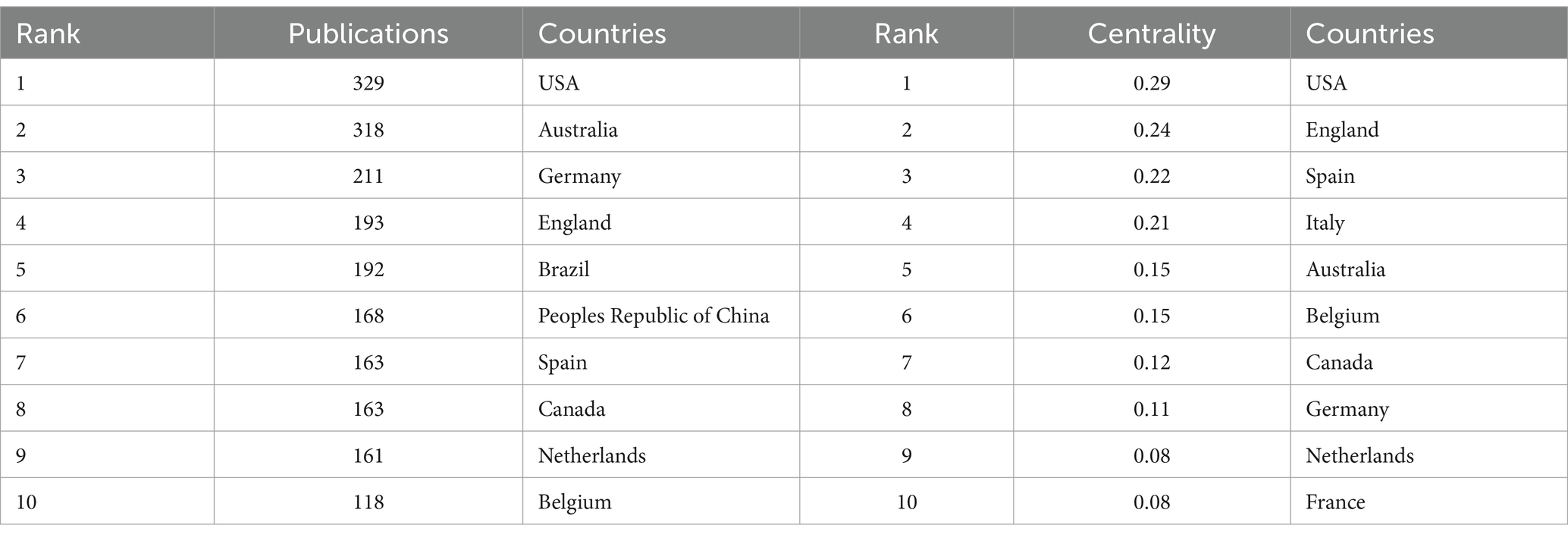
Table 4. Top 10 publications and centrality of countries related to non-specific low back pain (NSLBP).
Research institutions are important places for the production of scientific knowledge, and the distribution of power in the field of research can be understood by analyzing the collaborative relationships among different research institutions. In total, 2,103 articles were published by 367 research institutions dedicated to the study of NSLBP (Figure 5). The institution with the highest number of published articles was the University of Sydney (139 articles, 6.61%), followed by Vrije University Amsterdam (85 articles, 4.04%), Universidade Cidade de São Paulo (72 articles, 3.42%), the University of Southern Denmark (52 articles, 2.48%), and the George Institute for Global Health (45 articles, 2.14%). The highest centrality was found in Vrije Universiteit Amsterdam (0.20), followed by Harvard University (0.16), the University of Sydney (0.11), the University of London (0.11), and Keele University (0.10). The top 10 institutions in terms of article publication and centrality are shown in Table 5. The analysis shows that institutions in countries such as Australia, the USA, the United Kingdom, the Netherlands, and Brazil dominate the field of NSLBP research. Research institutions are mainly concentrated in comprehensive universities, with a small proportion of non-university or specialized research institutions. The various research institutions have close internal connections and relatively weak cross-regional cooperation, lacking cooperation and communication with research institutions from other countries. Implications as well as recommendations for enhancing such collaborations, would provide practical insights and broaden the horizons for researchers.
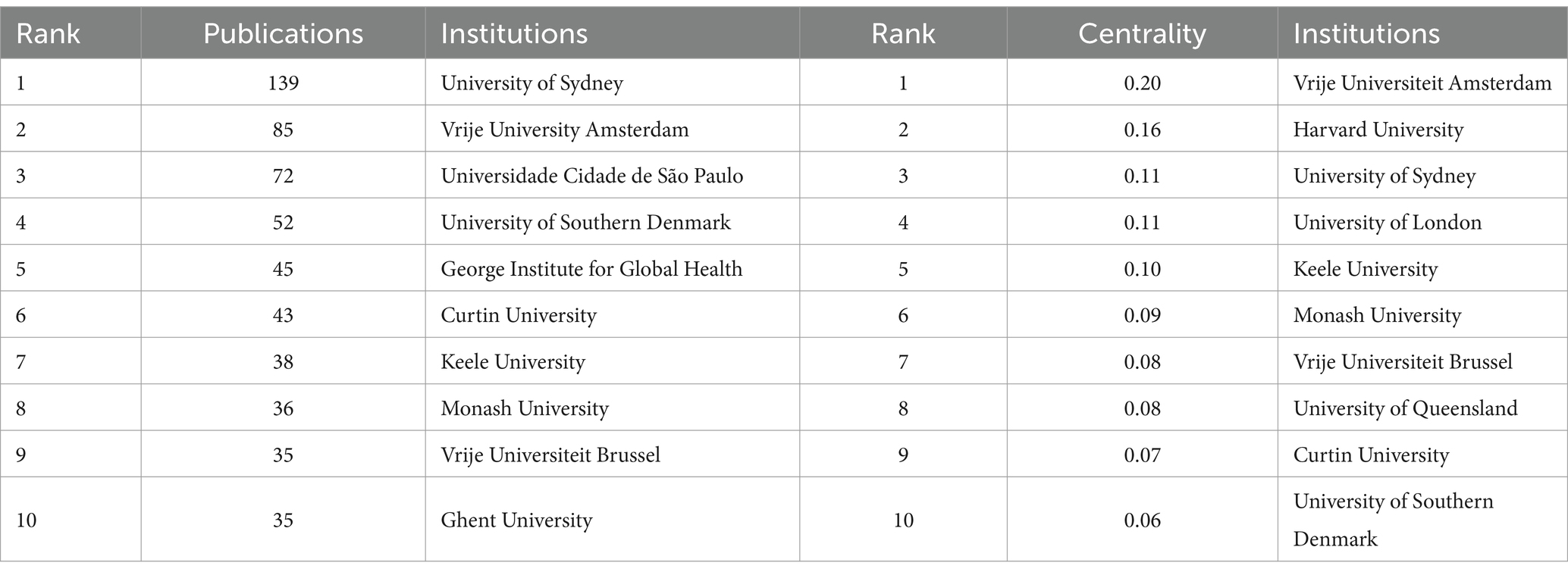
Table 5. Top 10 publications and centrality of institutions related to non-specific low back pain (NSLBP).
3.4 Analysis of authors and cited authors
A network map of author collaborations can be used to understand the number of articles published by the author in a certain field and to grasp the degree of cooperation between the research team to which the author belongs (Figure 6). The most prolific author in the study on NSLBP was Maher, Chris G (36 articles), followed by Pena Costa Leonardo Oliveira (23 articles), Danneels, Lieven (19 articles), Maher, Christopher G (17 articles), and Koes, Bart W (17 articles). The top 10 are shown in Table 6. Maher, Chris G is a staff member at the Institute of Musculoskeletal Health in Sydney, dedicated to researching clinical practice guidelines, Healthcare costs in emergency department, opioid use, and systematic reviews of NSLBP. He has provided reliable evidence and made the most prominent contribution to the field of NSLBP research. A comprehensive analysis showed that most of the research teams conducted the research independently, with close internal cooperation and less inter-team cooperation, which may be related to the different specialities and research directions of each team. If the research teams can strengthen cross-team, inter-disciplinary, and inter-specialty cooperation, there will be greater breakthroughs in the research related to NSLBP.
The co-citation network map of authors can identify the core authors in a certain research field and show the cross-citation relationship between literature related to NSLBP (Figure 7). The most frequently cited author was Hoy, D (571 articles, 27.15%), followed by Chou, R (468 articles, 22.25%), Hodges, PW (427 articles, 20.30%), Deyo, RA (409 articles, 19.45%), and Hayden, JA (327 articles, 15.55%). The authors with the highest centrality were Baliki, MN (0.07), followed by Hodges, PW, Moseley, GL, George, SZ, and Sullivan, MJL (0.04). Data on the frequency and centrality of the top 10 cited authors are shown in Table 7. In summary, Hoy, D and Baliki, MN have high activity and have conducted extensive research on NSLBP, making positive contributions to the development of this field.

Table 7. Top 10 frequency and centrality of cited authors related to non-specific low back pain (NSLBP).
3.5 Analysis of cited references
Analyzing reference co-occurrences is not only beneficial for searching out high-quality literature but also for understanding hot topics related to NSLBP [Figure 8, references (28–37)]. By counting the frequency of references, it is possible to determine the quality of the literature and the degree of repercussions in the professional field. The top 10 frequency rankings of references are shown in Table 8, which shows that these studies are the most highly influential in the field of NSLBP. Centrality measures the likelihood of any shortest path passing through a node in a network, which can guide us in finding the most valuable node in the network. The top 10 references with high centrality are listed in Table 9, references (38–44), indicating that these references play a crucial role in the field of NSLBP.
To obtain knowledge on the structure and dynamic change process of a certain research field, we used CiteSpace to automatically extract literature based on the co-occurrence of references. Cluster labels were generated based on the common relationships of the cited literature, and the likelihood ratio algorithm was used for label clustering. In this study, a total of 11 clusters were formed, among which “biomechanics,” “anxiety,” and “pain neuroscience education” were three important clustering results. The clustering module value was Q = 0.7588 and the average contour value was S = 0.8154 [Figure 9, references (45–65)]. Cluster module value refers to a method of demonstrating the importance and development level of a topic or cluster through specific measurement indicators such as density and centrality. Average contour value is a statistical indicator used to evaluate the quality of clustering algorithm results. It is mainly used to measure the tightness of members within a cluster and the degree of separation between clusters. Generally speaking, Q > 0.3 indicates a significantly better clustering structure, while S > 0.7 indicates a higher clustering feasibility. Based on the above analysis, research related to NSLBP has high credibility.
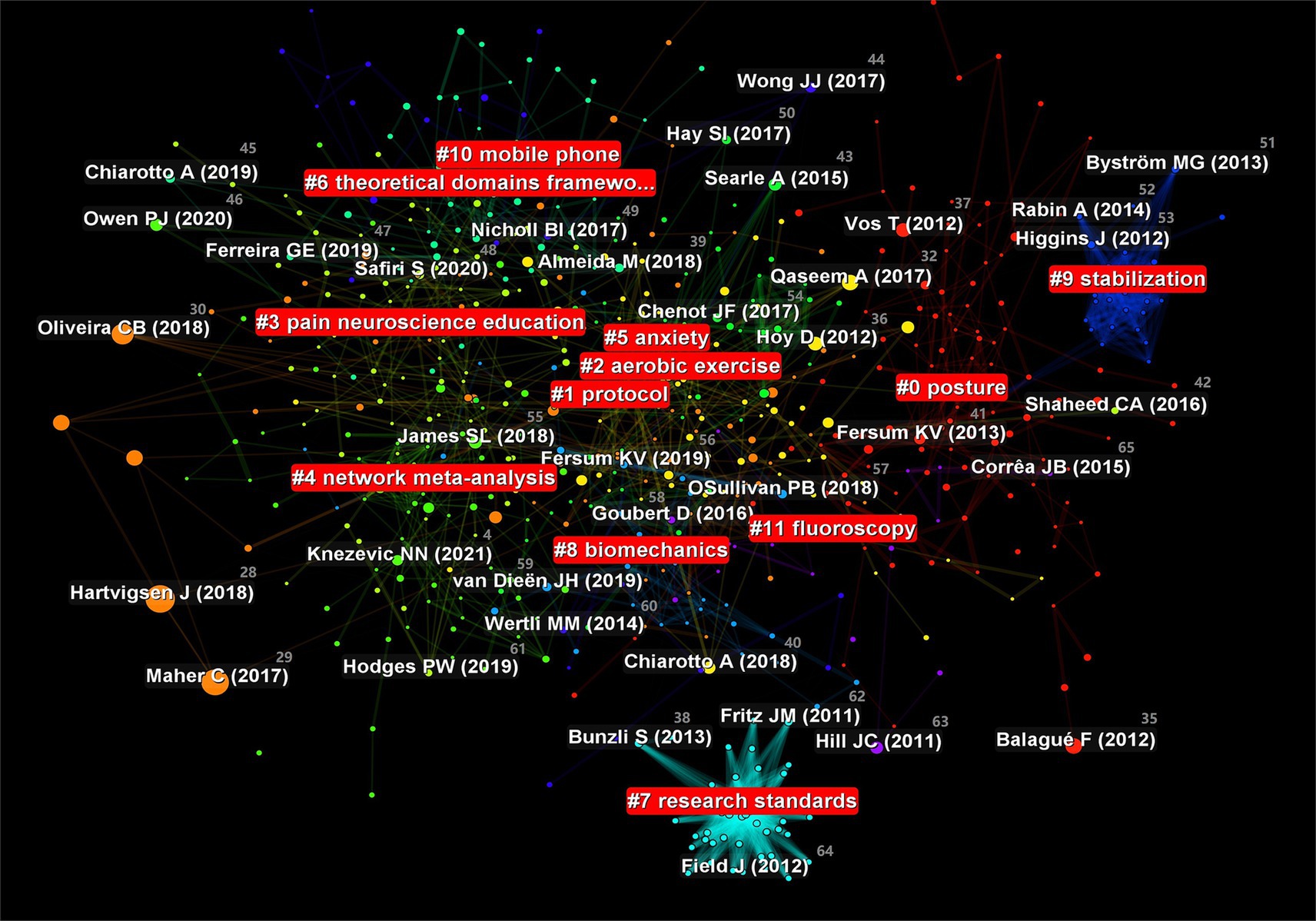
Figure 9. Cluster analysis map of co-citation references related to non-specific low back pain (NSLBP) from 2014 to 2023.
The lumbar spine is an important structure for maintaining spinal stability and range of motion, with complex biomechanical characteristics. Biomechanical changes are closely related to the occurrence of NSLBP (66).
There is a bidirectional relationship between NSLBP and anxiety, which often influence each other. The discomfort symptoms caused by NSLBP can lead to negative emotions, such as anxiety, in patients, which in turn accelerates the progression of NSLBP. The clinical application of anti-anxiety drugs to treat NSLBP not only effectively reduces anxiety, but also improves the factors of disability induced by NSLBP (67).
Pain neuroscience education (PNE) is an effective method for treating NSLBP. A single-blind randomized clinical trial showed that PNE achieved better results in reducing motor phobia and altering the perception of LBP intensity compared to purely therapeutic exercise (68).
3.6 Analysis of keywords
Keywords are highly summarized and condensed to the topic of the article. Through the analysis of keyword co-occurrence, we could obtain the central ideas and research hotspots in the field of NSLBP (Figure 10). We found that “low back pain,” “management,” “disability,” “reliability,” and “prevalence” were the most popular keywords (Table 10). Keyword clustering can summarize the main research clusters that have been developed in a field. In this study, a total of seven clusters were formed, among which “motor control” and “neck pain” were two important clustering results. The obtained keywords were clustered and analyzed by the clustering algorithm: Q = 0.3401 > 0.3, which indicates that the mapping clusters are well structured, and S = 0.7647 > 0.7, which indicates that the clusters have credibility (Figure 11). In general, the clusters are crisscrossed and closely linked. Research trends and hotspots in this field are focused on the therapeutic methods and associated diseases.
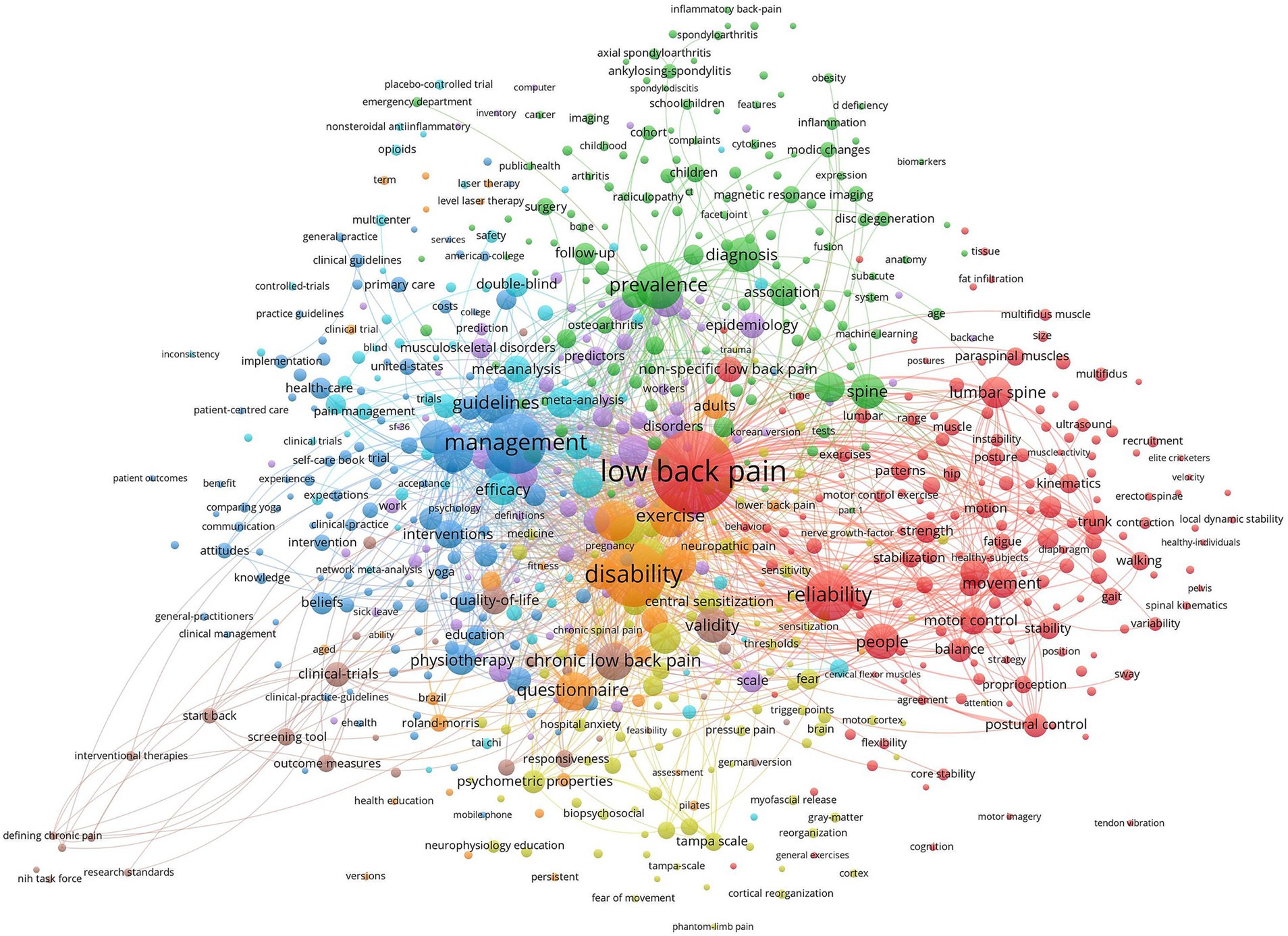
Figure 10. Map of keywords occurrence related to non-specific low back pain (NSLBP) from 2014 to 2023.
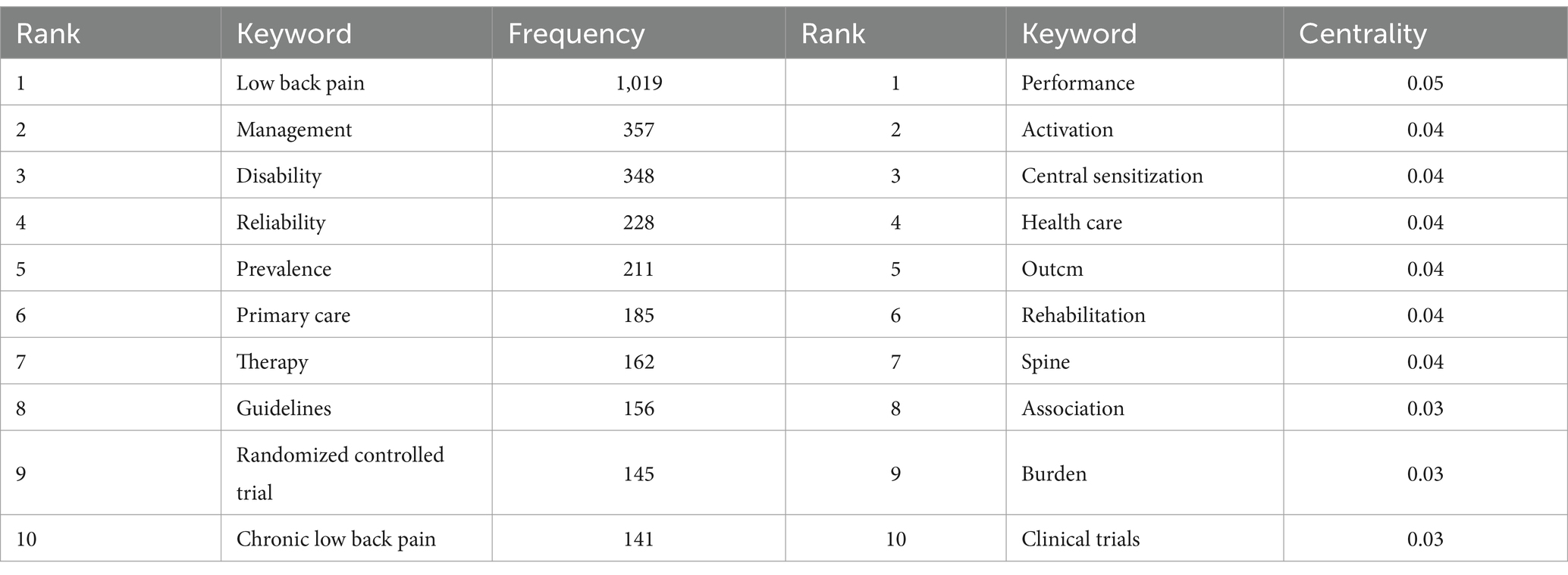
Table 10. Top 10 frequency and centrality of keywords related to non-specific low back pain (NSLBP).
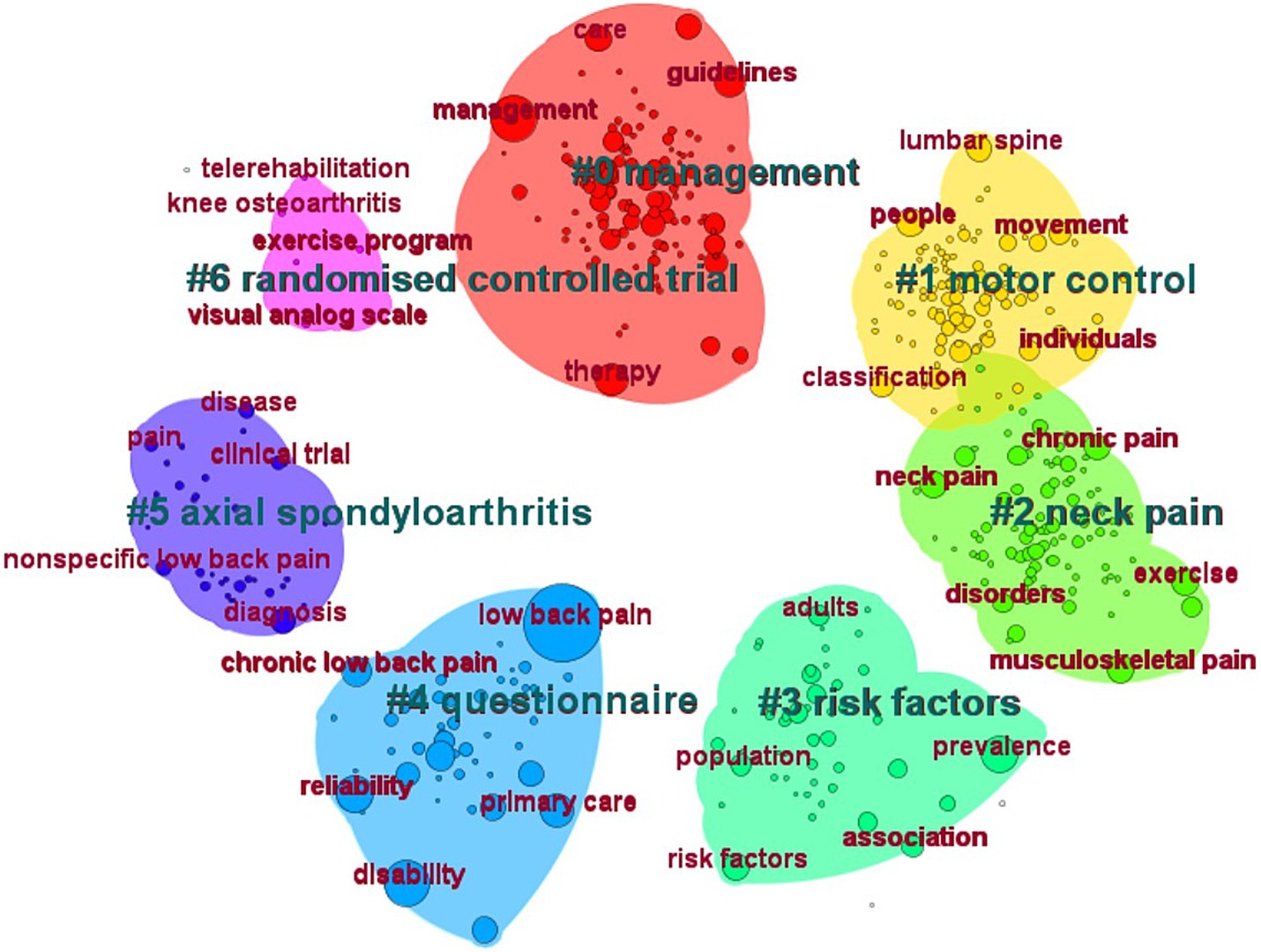
Figure 11. Cluster analysis map of co-citation keywords related to non-specific low back pain (NSLBP) from 2014 to 2023.
Keyword burst is a category of words that appear frequently and grow rapidly in a short period of time. It can roughly determine the research outbreaks and development trends that appear in each period of time and can be used to make a general prediction of the research trend. The top 20 keywords with the strongest citation bursts in 2014–2023 are shown in Figure 12. From 2014 to 2016 experts and scholars focused their research on treatment protocols including the design of randomized controlled trials follow-ups and updating method guidelines. The research direction of 2017–2023 is richer; we should pay special attention to high incidence population (adolescents) treatment methods (spinal manipulative therapy) treatment ideas (trunk muscle) and associated diseases (non-specific musculoskeletal pain fibromyalgia and musculoskeletal disorders) with NSLBP. The keyword timeline chart can reflect the development of the relevant hotspots in the field in each time period and through the analysis of the research vein the main development and evolution trend of the field can be grasped to a certain extent. The figure shows that acupuncture has a long time span (Figure 13) which indicates that in recent years researchers have used acupuncture as an alternative therapy to treat NSLBP. Furthermore it shows that research in this field is deepening and treatment methods are rich and diverse in recent years the proportion of adolescent cases of NSLBP has been continuously increasing. Backpack weight psychological issues lack of physical exercise obesity and abnormal posture are considered important factors causing NSLBP in adolescents (69, 70).
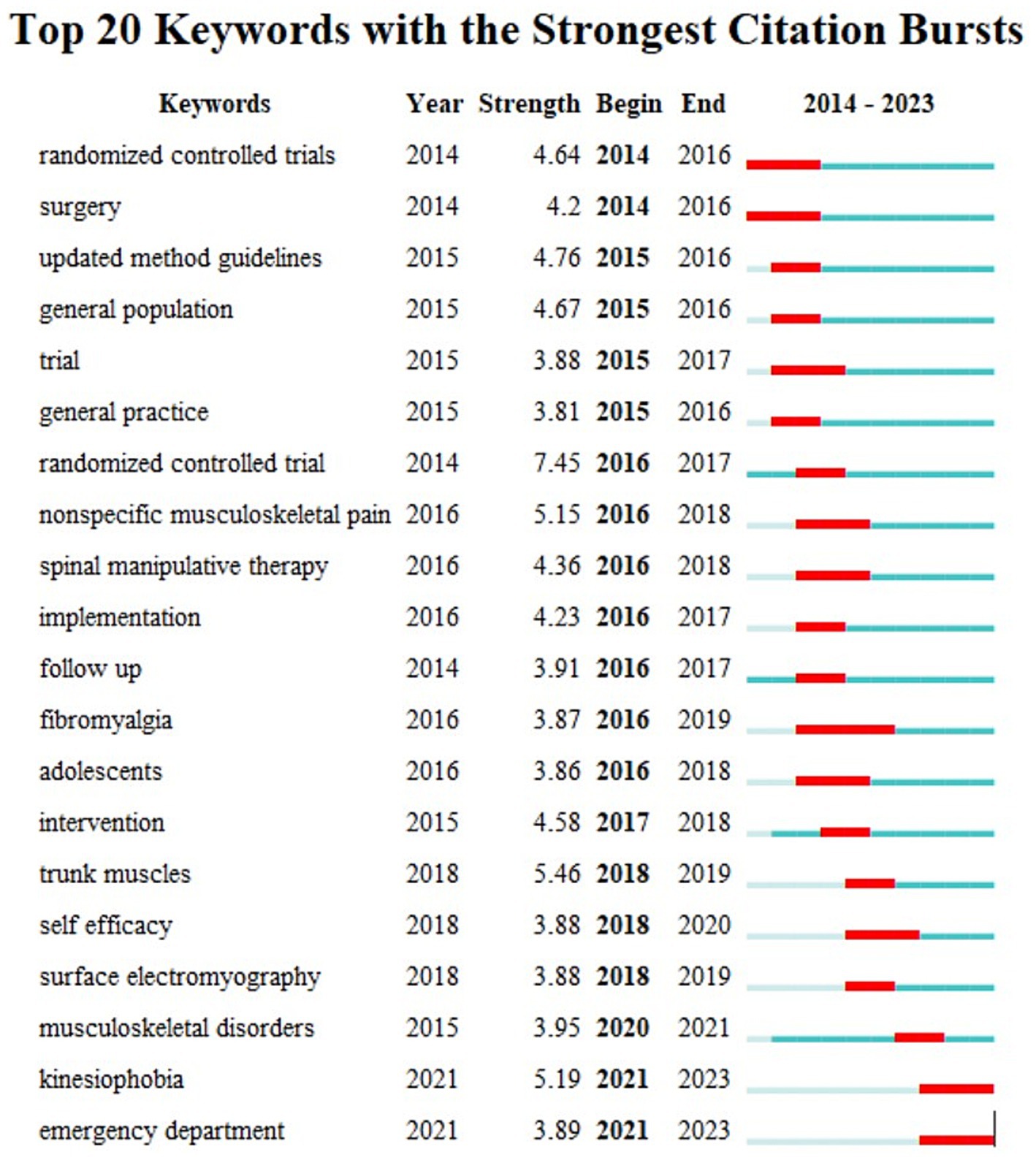
Figure 12. Top 20 keywords with the strongest citation bursts. The bolded Begin column demonstrates the start year of the keyword.
Motor control (MC) is one of the most popular and widely used treatment options for NSLBP, with multiple short-term and long-term advantages in reducing pain and disability (71). It has been suggested that this may be related through modulation of rsFC between the cerebellum and areas involved in sensory-discriminative processing of noxious and somato-sensory stimuli, affection, and cognition (72).
A study observed changes in the levels of inflammatory mediators, including tumor necrosis factor-alpha (TNFα), interleukin (IL)-6, and TNF soluble receptor type 2 (sTNFR2), which ultimately confirmed that spinal manipulative therapy (SMT) has good effects on both acute and chronic NSLBP (73). It could be inferenced that SMT may provide sufficient afferent stimulus to autonomic nervous system and provoke an anti-inflammatory reflex modulating the response of in flammatory cells (73).
As an alternative therapy, acupuncture has attracted the attention of researchers. A systematic review and meta-analysis showed that acupuncture treatment of acute/subacute NSLBP has significant advantages over oral drug treatment, with high safety and significant efficacy (p < 0.00001, I2 = 90%, SMD = −1.42, 95% CI: −2.22, −0.62) (74).
The trunk muscles are an important muscle group involved in lower back activity, playing a crucial role in maintaining lumbar stability. Trunk muscle dysfunction is often considered a key factor in inducing NSLBP (75, 76).
4 Conclusion
This study used 2,103 articles on NSLBP obtained from the WOSCC database from 2014 to 2023 as raw materials and used CiteSpace and VOSviewer as information visualization software to draw a series of knowledge graphs. Bibliometrics were used for statistical analysis to visually display the research status of NSLBP in the past decade, and objectively predict future hotspots and frontiers. In the past decade, the annual publication volume of NSLBP has shown an overall upward trend year by year, with obvious temporal stages and great development potential. In total, the 2,103 articles contain six types of literature, with the highest proportion being original research articles (1,633 articles, 77.65%). The literature has been published in 200 journals, with BMC Musculoskeletal Discourses (90 articles, 4.28%) having the highest number of publications, and the British Medical Journal having the highest IF (105.7). The USA (329 articles, 15.64%) had the highest publication volume, and the University of Sydney (139 articles, 6.61%) was the research institution with the highest production. Furthermore, Maher, Chris G (36 articles, 1.71%) was the author with the most published articles, and Hoy, D (571 articles, 27.15%) was the most frequently cited author. The most cited of articles is “Non-specific low back pain” published in the LANCET, with 1,256 citations.
The hotspots and frontiers of NSLBP can be summarized as follows: In recent years, adolescents have become a high-risk group for NSLBP. PNE, MC, SMT, and acupuncture are effective means to treat NSLBP. Biomechanics and trunk muscles as entry points are effective ideas for the treatment of NSLBP. Furthermore, anxiety, neck pain, non-specific musculoskeletal pain, fibromyalgia, and musculoskeletal disorders are diseases that are closely related to NSLBP. In the future, attention should be paid to the design of research plans, increasing the research intensity of randomized controlled trials, strengthening follow-ups, and providing timely updating of guidelines, thus resulting in higher quality and high-level scientific evidence for NSLBP research.
We found that the distribution of research institutions on NSLBP in the past decade has been uneven, with the vast majority concentrated in comprehensive universities and only a small portion in non-university or specialized research institutions. The research institutions were relatively scattered, with little academic cooperation and communication between them. Most research teams were in the independent research stage, resulting in close cooperation within the team and reduced cooperation between teams. Authoritative research institutions and core teams had not yet been formed. Therefore, in-depth cooperation and academic exchanges among different countries, institutions, teams, and authors from multiple disciplines, perspectives, and methods are strongly recommended to achieve complementary advantages, strengthen research capabilities, broaden research perspectives, and tap into academic resources, thus striving to release higher-level research results (77–80).
Although bibliometric methods provide a quantitative analytical tool, there are still some limitations in practical applications. It mainly focuses on the external characteristics of the literature, such as author, country and institution, without involving in-depth analysis of the content of the literature. This method is suitable for analyzing the macro structure and trends of literature, but it is insufficient for exploring the potential information and deep meanings in literature. In the future, other research methods such as content analysis should be combined to obtain more comprehensive and in-depth research results (21, 81, 82).
Data availability statement
The original contributions presented in the study are included in the article/supplementary material, further inquiries can be directed to the corresponding authors.
Author contributions
QM: Conceptualization, Methodology, Supervision, Writing – review & editing. YW: Project administration, Writing – original draft. SX: Data curation, Investigation, Writing – review & editing. DW: Data curation, Investigation, Writing – review & editing. GH: Formal analysis, Resources, Software, Visualization, Writing – review & editing. ZL: Formal analysis, Software, Visualization, Writing – review & editing. LJ: Funding acquisition, Validation, Writing – review & editing. ZC: Funding acquisition, Validation, Writing – review & editing.
Funding
The author(s) declare that financial support was received for the research, authorship, and/or publication of this article. This study was funded by the 2022 National Famous Old Chinese Medicine Experts Inheritance Studio Construction Project (NO: National Chinese Medicine Human Education Letter [2022] No. 75), the 2022 National Famous Chinese Medicine Inheritance Studio Construction Project (NO: Professor Rixin Chen), the Jiangxi Provincial Administration of Traditional Chinese Medicine on the Establishment of the Second Batch of Jiangxi Medical Thermal Moxibustion Quality Control Centre (NO: Gan Chinese Medicine Medical Administration Letter [2023] No. 1), Jiangxi Provincial Administration of Traditional Chinese Medicine Pediatric Tuina Key Research Laboratory Construction Project (NO: Gan Chinese Medicine Science and Education Letter [2022] No. 8), Major Project of Testing and Statistics Center of the State Administration of Traditional Chinese Medicine-Research on Statistical Data Standards for Traditional Chinese Medicine Services (No: 20230210), and Jiangxi Provincial Health Commission Science and Technology Plan Project (No: 202410044).
Acknowledgments
The authors would like to express their appreciation to Xiaoming Zhang, who provided writing guidance.
Conflict of interest
The authors declare that the research was conducted in the absence of any commercial or financial relationships that could be construed as a potential conflict of interest.
Publisher’s note
All claims expressed in this article are solely those of the authors and do not necessarily represent those of their affiliated organizations, or those of the publisher, the editors and the reviewers. Any product that may be evaluated in this article, or claim that may be made by its manufacturer, is not guaranteed or endorsed by the publisher.
References
1. GBD 2019 Diseases and Injuries Collaborators. Global burden of 369 diseases and injuries in 204 countries and territories, 1990-2019: a systematic analysis for the global burden of disease study 2019. Lancet. (2020) 396:1204–22. doi: 10.1016/S0140-6736(20)30925-9
2. Furlong, B, Etchegary, H, Aubrey-Bassler, K, Swab, M, Pike, A, and Hall, A. Patient education materials for non-specific low back pain and sciatica: a systematic review and meta-analysis. PLoS One. (2022) 17:e0274527. doi: 10.1371/journal.pone.0274527
3. Dieleman, JL, Cao, J, Chapin, A, Chen, C, Li, Z, Liu, A, et al. US health care spending by payer and health condition, 1996-2016. JAMA. (2020) 323:863–84. doi: 10.1001/jama.2020.0734
4. Knezevic, NN, Candido, KD, Vlaeyen, JWS, van Zundert, J, and Cohen, SP. Low back pain. Lancet. (2021) 398:78–92. doi: 10.1016/S0140-6736(21)00733-9
5. Hemmer, CR. Evaluation and treatment of low back pain in adult patients. Orthop Nurs. (2021) 40:336–42. doi: 10.1097/NOR.0000000000000804
6. Felício, DC, Filho, JE, de Oliveira, TMD, Pereira, DS, Rocha, VTM, Barbosa, JMM, et al. Risk factors for non-specific low back pain in older people: a systematic review with meta-analysis. Arch Orthop Trauma Surg. (2022) 142:3633–42. doi: 10.1007/s00402-021-03959-0
7. GBD 2015 Disease and Injury Incidence and Prevalence Collaborators. Global, regional, and national incidence, prevalence, and years lived with disability for 310 diseases and injuries, 1990-2015: a systematic analysis for the global burden of disease study 2015. Lancet. (2016) 388:1545–602. doi: 10.1016/S0140-6736(16)31678-6
8. Kim, B, and Yim, J. Core stability and hip exercises improve physical function and activity in patients with non-specific low back pain: a randomized controlled trial. Tohoku J Exp Med. (2020) 251:193–206. doi: 10.1620/tjem.251.193
9. Gianola, S, Bargeri, S, Del Castillo, G, Corbetta, D, Turolla, A, Andreano, A, et al. Effectiveness of treatments for acute and subacute mechanical non-specific low back pain: a systematic review with network meta-analysis. Br J Sports Med. (2022) 56:41–50. doi: 10.1136/bjsports-2020-103596
10. Enthoven, WT, Roelofs, PD, Deyo, RA, van Tulder, MW, and Koes, MW. Non-steroidal anti-inflammatory drugs for chronic low back pain. Cochrane Database Syst Rev. (2016) 2:CD012087. doi: 10.1002/14651858.CD012087
11. Cashin, AG, Folly, T, Bagg, MK, Wewege, MA, Jones, MD, Ferraro, MC, et al. Efficacy, acceptability, and safety of muscle relaxants for adults with non-specific low back pain: systematic review and meta-analysis. BMJ. (2021) 374:n1446. doi: 10.1136/bmj.n1446
12. Wewege, MA, Bagg, MK, Jones, MD, Ferraro, MC, Cashin, AG, Rizzo, RRN, et al. Comparative effectiveness and safety of analgesic medicines for adults with acute non-specific low back pain: systematic review and network meta-analysis. BMJ. (2023) 380:e072962. doi: 10.1136/bmj-2022-072962
13. Goldstein, JL, and Cryer, B. Gastrointestinal injury associated with NSAID use: a case study and review of risk factors and preventative strategies. Drug Healthc Patient Saf. (2015) 7:31–41. doi: 10.2147/DHPS.S71976
14. Hayden, JA, Ellis, J, Ogilvie, R, Stewart, SA, Bagg, MK, Stanojevic, S, et al. Some types of exercise are more effective than others in people with chronic low back pain: a network meta-analysis. J Physiother. (2021) 67:252–62. doi: 10.1016/j.jphys.2021.09.004
15. George, SZ, Fritz, JM, Silfies, SP, Schneider, MJ, Beneciuk, JM, Lentz, TA, et al. Interventions for the management of acute and chronic low back pain: revision 2021. J Orthop Sports Phys Ther. (2021) 51:CPG1–CPG60. doi: 10.2519/jospt.2021.0304
16. Tjøsvoll, SO, Mork, PJ, Iversen, VM, Rise, MB, and Fimland, MS. Periodized resistance training for persistent non-specific low back pain: a mixed methods feasibility study. BMC Sports Sci Med Rehabil. (2020) 12:30. doi: 10.1186/s13102-020-00181-0
17. Haile, G, Hailemariam, TT, and Haile, TG. Effectiveness of ultrasound therapy on the management of chronic non-specific low back pain: a systematic review. J Pain Res. (2021) 14:1251–7. doi: 10.2147/JPR.S277574
18. Giovanardi, CM, Gonzalez-Lorenzo, M, Poini, A, Marchi, E, Culcasi, A, Ursini, F, et al. Acupuncture as an alternative or in addition to conventional treatment for chronic non-specific low back pain: a systematic review and meta-analysis. Integr Med Res. (2023) 12:100972. doi: 10.1016/j.imr.2023.100972
19. Comachio, J, Oliveira, CC, Silva, IFR, Magalhães, MO, and Marques, AP. Effectiveness of manual and electrical acupuncture for chronic non-specific low back pain: a randomized controlled trial. J Acupunct Meridian Stud. (2020) 13:87–93. doi: 10.1016/j.jams.2020.03.064
20. Hani, U, Mulvaney, GG, O'Brien, MD, Jernigan, S, Kim, P, Holland, C, et al. Review: patent bibliometrics in cranial neurosurgery: the first bibliometric analysis of neurosurgery's technological literature. World Neurosurg. (2023) 171:115–23. doi: 10.1016/j.wneu.2022.12.103
21. Ninkov, A, Frank, JR, and Maggio, LA. Bibliometrics: methods for studying academic publishing. Perspect Med Educ. (2022) 11:173–6. doi: 10.1007/s40037-021-00695-4
22. Ling, F, Qi, W, Li, X, Zhou, J, Xiong, J, Zhao, Y, et al. Bibliometric analysis of acupuncture therapy for cancer pain over the past 10 years. J Pain Res. (2023) 16:985–1003. doi: 10.2147/JPR.S395421
23. Zhou, X, Kang, C, Hu, Y, and Wang, XC. Study on insulin resistance and ischemic cerebrovascular disease: a bibliometric analysis via CiteSpace. Front Public Health. (2023) 11:1021378. doi: 10.3389/fpubh.2023.1021378
24. Ye, Z, Mai, T, Cheng, Y, Zhang, X, Liu, Z, Zhang, Z, et al. Neurotoxicity of microplastics: a CiteSpace-based review and emerging trends study. Environ Monit Assess. (2023) 195:960. doi: 10.1007/s10661-023-11559-1
25. Miao, L, Shi, J, Yu, H, Song, L, Zhu, C, Shi, D, et al. Studies on atrial fibrillation and venous thromboembolism in the past 20 years: a bibliometric analysis via CiteSpace and VOSviewer. J Am Heart Assoc. (2023) 12:e029810. doi: 10.1161/JAHA.123.029810
26. du, Y, Cai, X, Xu, B, Wu, Y, Chen, M, Wang, J, et al. Global status and future trends of fascia and pain research in 2013-2022: bibliometric analysis based on CiteSpace and VOSviewer. J Pain Res. (2023) 16:2633–53. doi: 10.2147/JPR.S412161
27. Lu, F, Ren, P, Zhang, Q, and Shao, X. Research trends of acupuncture therapy on myofascial pain syndrome from 2000 to 2022: a bibliometric analysis. J Pain Res. (2023) 16:1025–38. doi: 10.2147/JPR.S401875
28. Hartvigsen, J, Hancock, MJ, Kongsted, A, Louw, Q, Ferreira, ML, Genevay, S, et al. What low back pain is and why we need to pay attention. Lancet. (2018) 391:2356–67. doi: 10.1016/S0140-6736(18)30480-X
29. Maher, C, Underwood, M, and Buchbinder, R. Non-specific low back pain. Lancet. (2017) 389:736–47. doi: 10.1016/S0140-6736(16)30970-9
30. Oliveira, CB, Maher, CG, Pinto, RZ, Traeger, AC, Lin, CWC, Chenot, JF, et al. Clinical practice guidelines for the management of non-specific low back pain in primary care: an updated overview. Eur Spine J. (2018) 27:2791–803. doi: 10.1007/s00586-018-5673-2
31. Foster, NE, Anema, JR, Cherkin, D, Chou, R, Cohen, SP, Gross, DP, et al. Prevention and treatment of low back pain: evidence, challenges, and promising directions. Lancet. (2018) 391:2368–83. doi: 10.1016/S0140-6736(18)30489-6
32. Qaseem, A, Wilt, TJ, McLean, RM, Forciea, MA, Clinical Guidelines Committee of the American College of PhysiciansDenberg, TD, et al. Noninvasive treatments for acute, subacute, and chronic low back pain: a clinical practice guideline from the American College of Physicians. Ann Intern Med. (2017) 166:514–30. doi: 10.7326/M16-2367
33. Buchbinder, R, van Tulder, M, Öberg, B, Costa, LM, Woolf, A, Schoene, M, et al. Low back pain: a call for action. Lancet. (2018) 391:2384–8. doi: 10.1016/S0140-6736(18)30488-4
34. Hoy, D, March, L, Brooks, P, Blyth, F, Woolf, A, Bain, C, et al. The global burden of low back pain: estimates from the global burden of disease 2010 study. Ann Rheum Dis. (2014) 73:968–74. doi: 10.1136/annrheumdis-2013-204428
35. Balagué, F, Mannion, AF, Pellisé, F, and Cedraschi, C. Non-specific low back pain. Lancet. (2012) 379:482–91. doi: 10.1016/S0140-6736(11)60610-7
36. Hoy, D, Bain, C, Williams, G, March, L, Brooks, P, Blyth, F, et al. A systematic review of the global prevalence of low back pain. Arthritis Rheum. (2012) 64:2028–37. doi: 10.1002/art.34347
37. Vos, T, Flaxman, AD, Naghavi, M, Lozano, R, Michaud, C, Ezzati, M, et al. Years lived with disability (YLDs) for 1160 sequelae of 289 diseases and injuries 1990-2010: a systematic analysis for the global burden of disease study 2010. Lancet. (2012) 380:2163–96. doi: 10.1016/S0140-6736(12)61729-2
38. Bunzli, S, Watkins, R, Smith, A, Schütze, R, and O’Sullivan, P. Lives on hold: a qualitative synthesis exploring the experience of chronic low-back pain. Clin J Pain. (2013) 29:907–16. doi: 10.1097/AJP.0b013e31827a6dd8
39. Almeida, M, Saragiotto, B, Richards, B, and Maher, CG. Primary care management of non-specific low back pain: key messages from recent clinical guidelines. Med J Aust. (2018) 208:272–5. doi: 10.5694/mja17.01152
40. Chiarotto, A, Boers, M, Deyo, RA, Buchbinder, R, Corbin, TP, Costa, LOP, et al. Core outcome measurement instruments for clinical trials in nonspecific low back pain. Pain. (2018) 159:481–95. doi: 10.1097/j.pain.0000000000001117
41. Vibe Fersum, K, O'Sullivan, P, Skouen, JS, Smith, A, and Kvåle, A. Efficacy of classification-based cognitive functional therapy in patients with non-specific chronic low back pain: a randomized controlled trial. Eur J Pain. (2013) 17:916–28. doi: 10.1002/j.1532-2149.2012.00252.x
42. Abdel Shaheed, C, Maher, CG, Williams, KA, Day, R, and McLachlan, AJ. Efficacy, tolerability, and dose-dependent effects of opioid analgesics for low back pain: a systematic review and meta-analysis. JAMA Intern Med. (2016) 176:958–68. doi: 10.1001/jamainternmed.2016.1251
43. Searle, A, Spink, M, Ho, A, and Chuter, V. Exercise interventions for the treatment of chronic low back pain: a systematic review and meta-analysis of randomised controlled trials. Clin Rehabil. (2015) 29:1155–67. doi: 10.1177/0269215515570379
44. Wong, JJ, Côté, P, Sutton, DA, Randhawa, K, Yu, H, Varatharajan, S, et al. Clinical practice guidelines for the noninvasive management of low back pain: a systematic review by the Ontario protocol for traffic injury management (OPTIMa) collaboration. Eur J Pain. (2017) 21:201–16. doi: 10.1002/ejp.931
45. Chiarotto, A, Maxwell, LJ, Ostelo, RW, Boers, M, Tugwell, P, and Terwee, CB. Measurement properties of visual analogue scale, numeric rating scale, and pain severity subscale of the brief pain inventory in patients with low back pain: a systematic review. J Pain. (2019) 20:245–63. doi: 10.1016/j.jpain.2018.07.009
46. Owen, PJ, Miller, CT, Mundell, NL, Verswijveren, SJJM, Tagliaferri, SD, Brisby, H, et al. Which specific modes of exercise training are most effective for treating low back pain? Network meta-analysis. Br J Sports Med. (2020) 54:1279–87. doi: 10.1136/bjsports-2019-100886
47. Ferreira, GE, Machado, GC, Abdel Shaheed, C, Lin, CWC, Needs, C, Edwards, J, et al. Management of low back pain in Australian emergency departments. BMJ Qual Saf. (2019) 28:826–34. doi: 10.1136/bmjqs-2019-009383
48. Safiri, S, Kolahi, AA, Hoy, D, Buchbinder, R, Mansournia, MA, Bettampadi, D, et al. Global, regional, and national burden of neck pain in the general population, 1990-2017: systematic analysis of the global burden of disease study 2017. BMJ. (2020) 368:m791. doi: 10.1136/bmj.m791
49. Nicholl, BI, Sandal, LF, Stochkendahl, MJ, McCallum, M, Suresh, N, Vasseljen, O, et al. Digital support interventions for the self-management of low back pain: a systematic review. J Med Internet Res. (2017) 19:e179. doi: 10.2196/jmir.7290
50. Hay, SI. Global, regional, and national incidence, prevalence, and years lived with disability for 328 diseases and injuries for 195 countries, 1990-2016: a systematic analysis for the global burden of disease study 2016. Lancet. (2017) 390:1211–59. doi: 10.1016/S0140-6736(17)32154-2
51. Byström, MG, Rasmussen-Barr, E, and Grooten, WJ. Motor control exercises reduces pain and disability in chronic and recurrent low back pain: a meta-analysis. Spine (Phila Pa 1976). (2013) 38:E350–8. doi: 10.1097/BRS.0b013e31828435fb
52. Rabin, A, Shashua, A, Pizem, K, Dickstein, R, and Dar, G. A clinical prediction rule to identify patients with low back pain who are likely to experience short-term success following lumbar stabilization exercises: a randomized controlled validation study. J Orthop Sports Phys Ther. (2014) 44:6–B13. doi: 10.2519/jospt.2014.4888
53. Higgins, J. Convincing evidence from controlled and uncontrolled studies on the lipid-lowering effect of a statin. Cochrane Database Syst Rev. (2012) 12:ED000049. doi: 10.1002/14651858.ED000049
54. Chenot, JF, Greitemann, B, Kladny, B, Petzke, F, Pfingsten, M, and Schorr, SG. Non-specific low back pain. Dtsch Arztebl Int. (2017) 114:883–90. doi: 10.3238/arztebl.2017.0883
55. James, SL. Global, regional, and national incidence, prevalence, and years lived with disability for 354 diseases and injuries for 195 countries and territories, 1990-2017: a systematic analysis for the global burden of disease study 2017. Lancet. (2018) 392:1789–858. doi: 10.1016/S0140-6736(18)32279-7
56. Vibe Fersum, K, Smith, A, Kvåle, A, Skouen, JS, and O'Sullivan, P. Cognitive functional therapy in patients with non-specific chronic low back pain-a randomized controlled trial 3-year follow-up. Eur J Pain. (2019) 23:1416–24. doi: 10.1002/ejp.1399
57. O’Sullivan, PB, Caneiro, JP, O’Keeffe, M, Smith, A, Dankaerts, W, Fersum, K, et al. Cognitive functional therapy: an integrated behavioral approach for the targeted management of disabling low back pain. Phys Ther. (2018) 98:408–23. doi: 10.1093/ptj/pzy022
58. Goubert, D, Oosterwijck, JV, Meeus, M, and Danneels, L. Structural changes of lumbar muscles in non-specific low back pain: a systematic review. Pain Physician. (2016) 19:E985–E1000. doi: 10.36076/ppj/2016.19.E985
59. van Dieën, JH, Reeves, NP, Kawchuk, G, van Dillen, LR, and Hodges, PW. Motor control changes in low back pain: divergence in presentations and mechanisms. J Orthop Sports Phys Ther. (2019) 49:370–9. doi: 10.2519/jospt.2019.7917
60. Wertli, MM, Rasmussen-Barr, E, Weiser, S, Bachmann, LM, and Brunner, F. The role of fear avoidance beliefs as a prognostic factor for outcome in patients with nonspecific low back pain: a systematic review. Spine J. (2014) 14:816–836.e4. doi: 10.1016/j.spinee.2013.09.036
61. Hodges, PW, and Danneels, L. Changes in structure and function of the back muscles in low back pain: different time points, observations, and mechanisms. J Orthop Sports Phys Ther. (2019) 49:464–76. doi: 10.2519/jospt.2019.8827
62. Fritz, JM, Beneciuk, JM, and George, SZ. Relationship between categorization with the STarT back screening tool and prognosis for people receiving physical therapy for low back pain. Phys Ther. (2011) 91:722–32. doi: 10.2522/ptj.20100109
63. Hill, JC, Whitehurst, DG, Lewis, M, Bryan, S, Dunn, KM, Foster, NE, et al. Comparison of stratified primary care management for low back pain with current best practice (STarT Back): a randomised controlled trial. Lancet. (2011) 378:1560–71. doi: 10.1016/S0140-6736(11)60937-9
64. Field, J, and Newell, D. Relationship between STarT back screening tool and prognosis for low back pain patients receiving spinal manipulative therapy. Chiropr Man Therap. (2012) 20:17. doi: 10.1186/2045-709X-20-17
65. Corrêa, JB, Costa, LO, de Oliveira, NT, Sluka, KA, and Liebano, RE. Central sensitization and changes in conditioned pain modulation in people with chronic nonspecific low back pain: a case-control study. Exp Brain Res. (2015) 233:2391–9. doi: 10.1007/s00221-015-4309-6
66. Abd Rahman, NA, Li, S, Schmid, S, and Shaharudin, S. Biomechanical factors associated with non-specific low back pain in adults: a systematic review. Phys Ther Sport. (2023) 59:60–72. doi: 10.1016/j.ptsp.2022.11.011
67. Onda, A, and Kimura, M. Reduction in anxiety during treatment with exercise and duloxetine is related to improvement of low back pain-related disability in patients with non-specific chronic low back pain. Fukushima J Med Sci. (2020) 66:148–55. doi: 10.5387/fms.2020-22
68. Yamada, AS, Antunes, FTT, Vaz, SMR, Saraiva, BV, de Souza, AH, and Simon, D. Physiotherapeutic treatment associated with the pain neuroscience education for patients with chronic non-specific low back pain-single-blind randomized pilot clinical trial. Agri. (2023) 35:153–66. doi: 10.14744/agri.2022.33349
69. García-Moreno, JM, Calvo-Muñoz, I, Gómez-Conesa, A, and López-López, JA. Assessment of the effects of physiotherapy on back care and prevention of non-specific low back pain in children and adolescents: a systematic review and meta-analysis. Healthcare (Basel). (2024) 12:1036. doi: 10.3390/healthcare12101036
70. Calvo-Muñoz, I, Kovacs, FM, Roqué, M, Gago Fernández, I, and Seco Calvo, J. Risk factors for low back pain in childhood and adolescence: a systematic review. Clin J Pain. (2018) 34:468–84. doi: 10.1097/AJP.0000000000000558
71. Zhang, C, Li, Y, Zhong, Y, Feng, C, Zhang, Z, and Wang, C. Effectiveness of motor control exercise on non-specific chronic low back pain, disability and core muscle morphological characteristics: a meta-analysis of randomized controlled trials. Eur J Phys Rehabil Med. (2021) 57:793–806. doi: 10.23736/S1973-9087.21.06555-2
72. Zhang, C, Zhang, Z, Li, Y, Yin, Y, Feng, C, Zhan, W, et al. Alterations in functional connectivity in patients with non-specific chronic low back pain after motor control exercise: a randomized trial. Eur J Phys Rehabil Med. (2024) 60:319–30. doi: 10.23736/S1973-9087.24.08087-0
73. Teodorczyk-Injeyan, JA, Triano, JJ, Gringmuth, R, DeGraauw, C, Chow, A, and Injeyan, HS. Effects of spinal manipulative therapy on inflammatory mediators in patients with non-specific low back pain: a non-randomized controlled clinical trial. Chiropr Man Therap. (2021) 29:3. doi: 10.1186/s12998-020-00357-y
74. Lin, H, Wang, X, Feng, Y, Liu, X, Liu, L, Zhu, K, et al. Acupuncture versus oral medications for acute/subacute non-specific low back pain: a systematic review and meta-analysis. Curr Pain Headache Rep. (2024) 28:489–500. doi: 10.1007/s11916-023-01201-7
75. Hemming, R, Sheeran, L, van Deursen, R, and Sparkes, V. Investigating differences in trunk muscle activity in non-specific chronic low back pain subgroups and no-low back pain controls during functional tasks: a case-control study. BMC Musculoskelet Disord. (2019) 20:459. doi: 10.1186/s12891-019-2843-2
76. Kato, S, Demura, S, Kurokawa, Y, Takahashi, N, Shinmura, K, Yokogawa, N, et al. Efficacy and safety of abdominal trunk muscle strengthening using an innovative device in elderly patients with chronic low back pain: a pilot study. Ann Rehabil Med. (2020) 44:246–55. doi: 10.5535/arm.19100
77. Luo, D, Wang, J, Wang, Z, Fang, F, Kang, Y, and Chen, O. The development trend of medical animals in the last ten years: a review. Iran J Public Health. (2023) 52:1334–45. doi: 10.18502/ijph.v52i7.13235
78. Wei, N, Hu, Y, Liu, G, Li, S, Yuan, G, Shou, X, et al. A bibliometric analysis of familial hypercholesterolemia from 2011 to 2021. Curr Probl Cardiol. (2023) 48:101151. doi: 10.1016/j.cpcardiol.2022.101151
79. Ceska, R, Latkovskis, G, Ezhov, MV, Freiberger, T, Lalic, K, Mitchenko, O, et al. The impact of the international cooperation on familial hypercholesterolemia screening and treatment: results from the ScreenPro FH project. Curr Atheroscler Rep. (2019) 21:36. doi: 10.1007/s11883-019-0797-3
80. Tang, Y, He, G, He, Y, and He, T. Plant resistance to fungal pathogens: bibliometric analysis and visualization. Toxics. (2022) 10:624. doi: 10.3390/toxics10100624
81. Liu, Z, Li, Z, Zhang, Y, Mutukumira, AN, Feng, Y, Cui, Y, et al. Comparing business, innovation, and platform ecosystems: a systematic review of the literature. Biomimetics (Basel). (2024) 9:216. doi: 10.3390/biomimetics9040216
Keywords: non-specific low back pain, bibliometrics, CiteSpace, hotspots, frontiers
Citation: Mao Q, Wang Y, Xu S, Wu D, Huang G, Li Z, Jiao L and Chi Z (2024) Research hotspots and frontiers in non-specific low back pain: a bibliometric analysis. Front. Neurol. 15:1464048. doi: 10.3389/fneur.2024.1464048
Edited by:
Wanli Zang, Harbin Sport University, ChinaReviewed by:
Ningkun Xiao, Ural Federal University, RussiaJeneviv John, University of Nigeria, Nsukka, Nigeria
Saranya Sivasubramanian, SSN College of Engineering, India
Copyright © 2024 Mao, Wang, Xu, Wu, Huang, Li, Jiao and Chi. This is an open-access article distributed under the terms of the Creative Commons Attribution License (CC BY). The use, distribution or reproduction in other forums is permitted, provided the original author(s) and the copyright owner(s) are credited and that the original publication in this journal is cited, in accordance with accepted academic practice. No use, distribution or reproduction is permitted which does not comply with these terms.
*Correspondence: Lin Jiao, amwwODA5QDEyNi5jb20=; Zhenhai Chi, MzQ4OTE2NjYxQHFxLmNvbQ==
†These authors have contributed equally to this work
 Qiangjian Mao
Qiangjian Mao Yuqing Wang
Yuqing Wang Shiqi Xu2
Shiqi Xu2